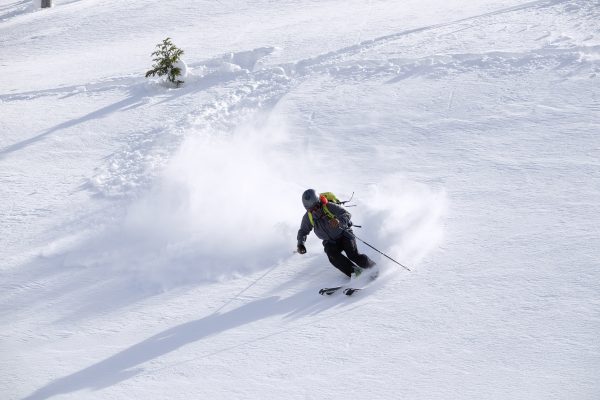As an emergency department physician, I’m more useful in diagnosing acute knee injuries than discussing chronic knee pain with friends and strangers at après ski, so I chatted about various treatment options of osteoarthritis (OA) with an expert, director of sports medicine at the University of Toronto, Dr. Mark Leung.

OA is the result of chronic wear and tear of the knee cartilage, which becomes thinner as we age. Prior knee injuries, excess weight and genetics are the main factors that predispose a middle-aged skier to OA of the knee.
The diagnosis is made fairly easily by health care providers through a combination of patient history, physical examination and sometimes an X-ray. An MRI is not necessary to confirm OA.
The treatment options available depend on the severity of the OA, with a full knee replacement being the ultimate solution. I’ll discuss surgical options for knee OA in the next issue, but for now I’ll focus on non-surgical options.
Over-the-Counter Painkillers
Generally equivalent to prescription anti-inflammatory medications, ibuprofen (Advil) and acetaminophen (Tylenol) can be taken as directed for pain relief. The prescription versions are not necessarily stronger, but have the advantage of dosing fewer times per day.
Exercise
Curiously, exercise has been shown to reduce knee OA pain and make it easier to do daily activities. Specific evidence-based programs for knee OA exercise may be covered by your provincial health services. Talk to your medical doctor or physiotherapist about the GLA:D Canada OA exercise program.
Weight Loss
Along with many other benefits, dropping extra pounds is a proven way to delay the progression of OA.
Knee Joint Injections
If the above treatment options are insufficient, injections may be an option. There are three main types: steroidal, hyaluronic acid and plasma rich protein.
The most accessible and affordable option is corticosteroid injection. Covered by most provincial health plans, this can be done by many family physicians as well as specialists. It provides most people with pain relief that starts within a few days and can last up to a few months. The average pain reduction is about 10 to 20 per cent, but this type of injection should not be done more than three times per year.
Hyaluronic acid (HA) injection is an intuitive treatment choice for knee OA because HA is one of the main components of joint fluid, acting as a lubricant. HA joint injection has been available for about 25 years, and the evidence supporting its use has been variable. Initial pharmaceutical-sponsored studies showed dramatic results, but later studies were more modest. Overall, HA provides slightly better pain relief (20 to 30 per cent reduction) and longer relief (up to six months) than a steroid injection. The downside of HA is the cost, about $500. The physician fee is also paid for out-of-pocket. Most private extended health benefit plans will cover the cost of HA, but typically no provincial plans.
Plasma rich protein (PRP) injection has been available for knee OA over the past decade or so. PRP is made from components of a patient’s own blood, which are separated and then injected into the injured body part. PRP was initially used for tendon repair but can also relieve pain from OA. The pain relief from PRP is similar to HA and may last longer. PRP initially gained popularity with professional athletes, including Tiger Woods. The main downside of PRP is the cost, which can start at $700 per treatment, and I’m not aware of any provincial or extended health benefits coverage.
Unfortunately, none of the above treatment options have been shown to reverse or repair the damage of OA, but they can improve symptoms and allow you to continue shredding past middle-age.
Dr. John Foote is an emergency room physician at Toronto’s Mount Sinai Hospital and a Devil’s Glen skier.



